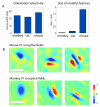What can mice tell us about how vision works?
- PMID: 21840069
- PMCID: PMC3371366
- DOI: 10.1016/j.tins.2011.07.002
What can mice tell us about how vision works?
Abstract
Understanding the neural basis of visual perception is a long-standing fundamental goal of neuroscience. Historically, most vision studies were carried out on humans, macaques and cats. Over the past 5 years, however, a growing number of researchers have begun using mice to parse the mechanisms underlying visual processing; the rationale is that, despite having relatively poor acuity, mice are unmatched in terms of the variety and sophistication of tools available to label, monitor and manipulate specific cell types and circuits. In this review, we discuss recent advances in understanding the mouse visual system at the anatomical, receptive field and perceptual level, focusing on the opportunities and constraints those features provide toward the goal of understanding how vision works.
Copyright © 2011 Elsevier Ltd. All rights reserved.
Figures




References
-
- Werner JS, Chalupa LM. The visual neurosciences. MIT Press; Cambridge, Mass.: 2004.
-
- Jacobs GH. Primate color vision: a comparative perspective. Vis Neurosci. 2008;25(5-6):619–33. - PubMed
-
- Prusky GT, Douglas RM. Characterization of mouse cortical spatial vision. Vision Res. 2004;44(28):3411–8. - PubMed
Publication types
MeSH terms
Grants and funding
LinkOut - more resources
Full Text Sources
Other Literature Sources
Miscellaneous

